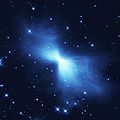Berkas:Boomerang nebula.jpg

Ukuran pratayang ini: 600 × 600 piksel. Resolusi lainnya: 240 × 240 piksel | 480 × 480 piksel | 768 × 768 piksel | 1.024 × 1.024 piksel | 1.590 × 1.590 piksel.
Ukuran asli (1.590 × 1.590 piksel, ukuran berkas: 249 KB, tipe MIME: image/jpeg)
Riwayat berkas
Klik pada tanggal/waktu untuk melihat berkas ini pada saat tersebut.
| Tanggal/Waktu | Miniatur | Dimensi | Pengguna | Komentar | |
|---|---|---|---|---|---|
| terkini | 19 Mei 2007 15.29 |  | 1.590 × 1.590 (249 KB) | Pamputt | {{Information |Description= |Source= |Date= |Author= |Permission= |other_versions= }} |
Penggunaan berkas
2 halaman berikut menggunakan berkas ini:
Penggunaan berkas global
Wiki lain berikut menggunakan berkas ini:
- Penggunaan pada ar.wikipedia.org
- Penggunaan pada ast.wikipedia.org
- Penggunaan pada bn.wikipedia.org
- Penggunaan pada ca.wikipedia.org
- Penggunaan pada cs.wikipedia.org
- Penggunaan pada da.wikipedia.org
- Penggunaan pada de.wikipedia.org
- Penggunaan pada en.wikipedia.org
- Penggunaan pada en.wikiversity.org
- Penggunaan pada en.wiktionary.org
- Penggunaan pada es.wikipedia.org
- Penggunaan pada eu.wikipedia.org
- Penggunaan pada fa.wikipedia.org
- Penggunaan pada fi.wikiversity.org
- Penggunaan pada fr.wikipedia.org
- Penggunaan pada he.wikipedia.org
- Penggunaan pada hu.wikipedia.org
- Penggunaan pada hy.wikipedia.org
- Penggunaan pada it.wikipedia.org
- Penggunaan pada it.wikibooks.org
- Penggunaan pada ja.wikipedia.org
- Penggunaan pada ko.wikipedia.org
- Penggunaan pada lb.wikipedia.org
- Penggunaan pada mk.wikipedia.org
- Penggunaan pada nl.wikipedia.org
Lihat lebih banyak penggunaan global dari berkas ini.



